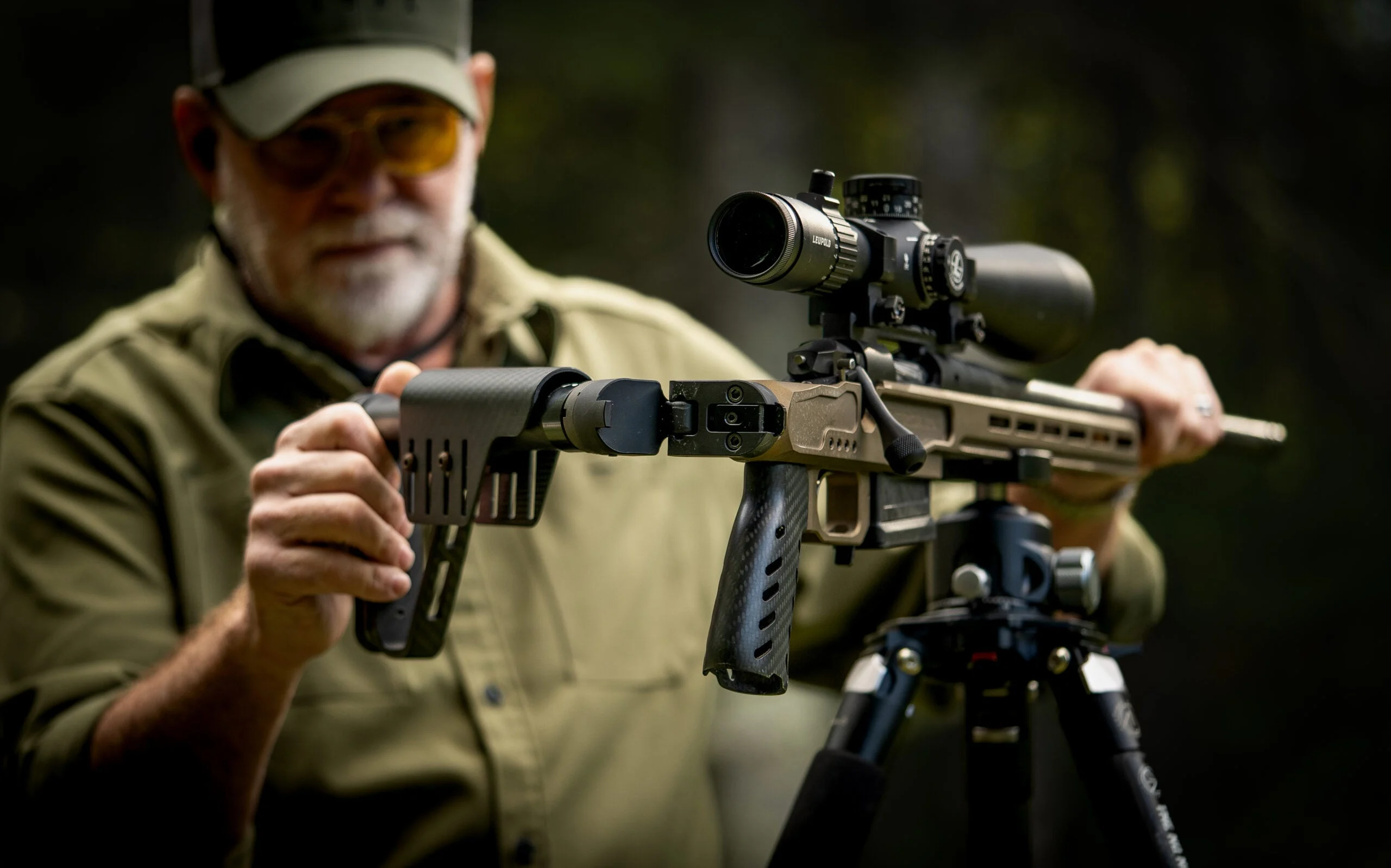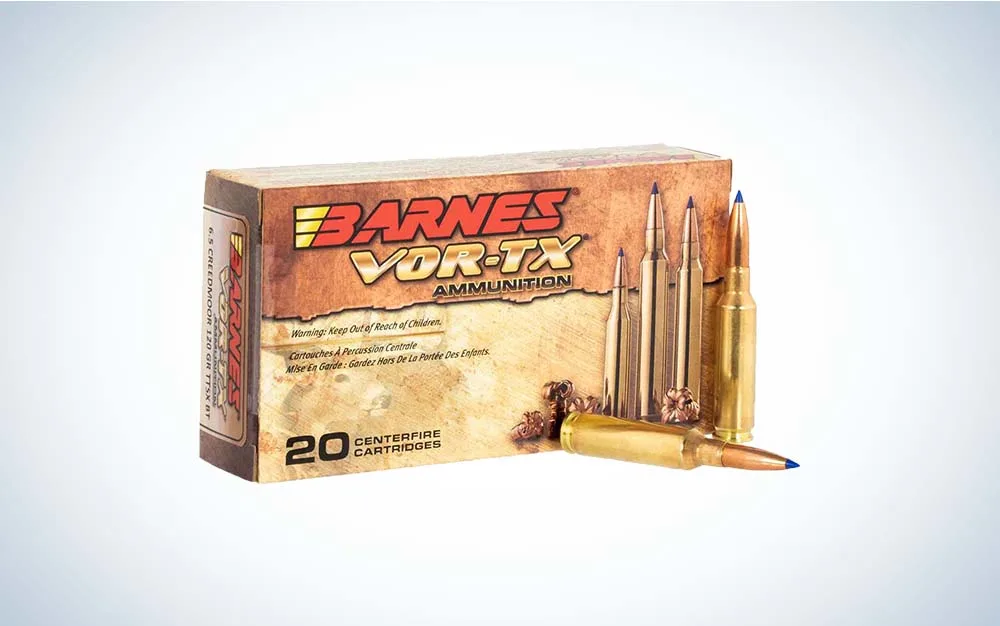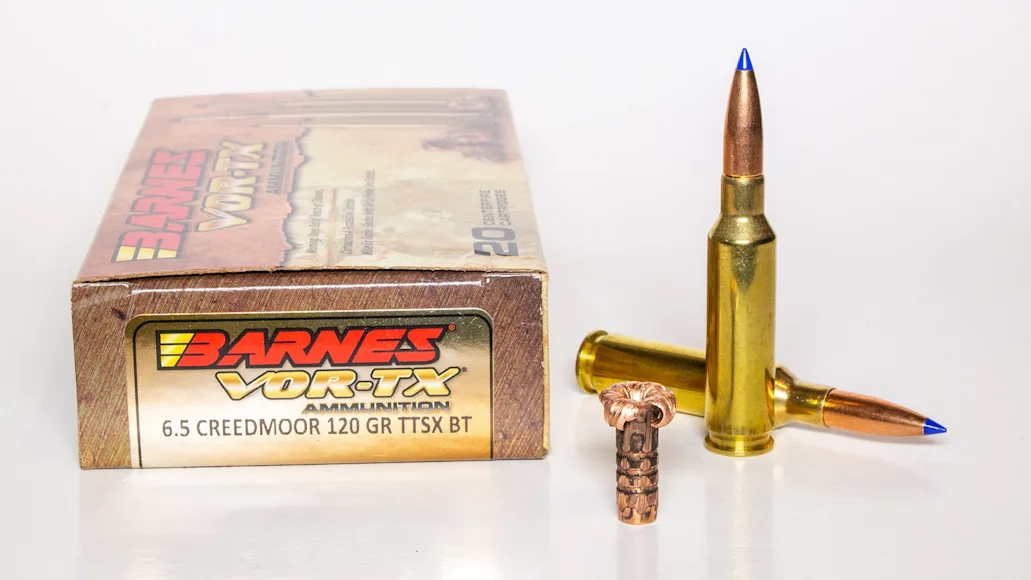_We may earn revenue from the products available on this page and participate in affiliate programs. Learn more ›
_
Barnes Vor-TX hunting ammunition features all-copper bullets that have a strong a dedicated following by hunters for several reasons. Since their upset is generally limited to two times or a bit less than original bullet diameter, and since they retain nearly all their weight, these bullets penetrate very deeply. Unlike the original Barnes X-Bullets, the newer Triple Shock (TSX) and Tipped Triple Shock (TTSX) bullets also typically deliver good precision
. The Vor-TX TTSX 6.5 Creedmoor
load I tested for this F&S Bullet Lab is, as the name indicates, loaded with latter. In many rifles, these bullets shoot just as well as match bullets. And finally, these bullets contain no lead. Not only do some locations mandate lead-free bullets for big-game hunting, but some hunters also like the idea that the animal they will eat will not contain lead particles in the meat.
Barnes TSX and TTSX bullets are essentially hollow-point bullets. The small cavity at the bullet’s nose is designed to fill with fluid from the animal and this drives bullet upset. With the TTSX bullet that hollow-point cavity is filled with a Delrin—polymer tip—and it initially takes the place of the fluid. It is also supposed to slightly reduce the impact velocity needed for bullet upset. I’ve taken a good many big game animals with Tipped Triple Shock bullets and have been pleased with the results, but it’s been clear that the higher the impact velocity, the better these bullets work. Recently, I loaded up with Barnes Vor-TX 6.5 Creedmoor
ammo and fired the TTSX bullet into ballistics gel measure it’s performance more precisely. Here are the results.
**Related: Dude, the 6.5 Creedmoor Sucks!
**
Barnes Vor-TX TTSX 6.5 Creedmoor Velocity
Out of a Nosler Model 21 rifle that has a 22-inch Shilen barrel, this load had an average muzzle velocity of 2776 fps, with a standard velocity deviation of only 19.7 fps. Barnes advertises this load as having a muzzle velocity of 2910 fps, which was most likely obtained with a 24-inch barrel and is about standard for 120-grain 6.5 Creedmoor
ammunition. Like with most 120-grain 6.5mm bullets, the BC is below 0.500, so you’re not going to see that extremely flat trajectory the 6.5 Creedmoor is famous for. And this bullet needs to impact at a velocity of 2000 fps or faster for meaningful bullet upset. Out of this rifle, this bullet will fall below 2000 fps at just the other side of 400 yards, which should be considered its maximum practical range.
Barnes Vor-TX TTSX 6.5 Creedmoor Precision

The average of three three-shot groups measured 1.10 inches. Sabastian Mann
I fired three, three-shot groups off a sandbag rest with the Nosler rifle, which was wearing Tract Toric 2.5-15X44 riflescope set at maximum magnification. The average for those three groups was 1.10 inches. This is plenty of precision to take this bullet out to its maximum practical range of about 400 yards on big game. But there is something you should keep in mind when precision testing all-copper bullets of any manufacture. Due to the different barrel fouling characteristics of mono-metal bullets, if you’ve been shooting traditional lead-core bullets in your rifle, you will typically see better precision with the mono-metal bullets if you thoroughly clean your rifle’s barrel first. This was not done with the Model 21, but in other rifles I’ve seen mono-metal bullet group sizes shrink as much as 50 percent after a good barrel cleaning. The Nosler Model 21 is a very good shooting rifle, and the 1.1-inch group average for this Barnes Vor-TX load was equal to the average for the more than a dozen different loads that have been tested out of this rifle.

Vor-TX TTSX 6.5 Creedmoor Trajectory
A hallmark of the 6.5 Creedmoor is its ability to deliver a flat trajectory without excessive recoil. For the flattest long-distance trajectories with the 6.5 Creedmoor, you’ll need a bullet with a BC of more than 0.500, and those will typically weigh more than 140 grains. This bullet does not have a high BC, but it partially makes up for its lower BC with velocity. Out to 600 yards, it will shoot flatter than a 140-grain bullet with a 0.500 BC. But at that distance, it will impact with about 20 percent less energy.

A breakdown Barnes Vor-TX TTSX’s external ballistics, including trajectory. Richard Mann
Everything with ammunition is a tradeoff, and the hunter must decide what ballistic traits are the most important to them. This is not long-range big-game bullet, but it should do very well on any big-game animal the 6.5 Creedmoor is suited for out to 400 yards or so. If a long-range mono-metal bullet for the Creed is what you’re looking for, Barnes offers a 127-grain load for the Creedmoor that has a BC of 0.468, and an advertised muzzle velocity of 2850 fps. But that bullet will only give you about another 100 yards of reach before it will impact at a velocity of less than 2000 fps.
Vor-TX TTSX 6.5 Creedmoor Terminal Performance
If you like the idea of crush-cavity size to determine the potential lethality of a bullet, this 120-grain TTSX penetrated 31.5 inches and deformed with a frontal diameter of 0.494 inch, for a crush cavity size of 5.99 cubic inches. However, to damage 5.99 cubic inches of animal internals, the bullet would need to remain in the animal for the full 31.5 inches. On a broadside shot this is unlikely. On the other hand, with this bullet’s ability to fully penetrate, on broadside shots on deer-sized game an exit is almost a guarantee. Some hunters like the idea of animals bleeding out of two holes as opposed to one, especially since entry holes are usually small and let out very little blood, because it makes tracking easier.

This breakdown lists all of the measured results of the bullet test, including velocity, precision, and terminal ballistics data. Sabastian Mann
If you like the idea of a bullet that will retain 100 percent of its weight and penetrate very deeply, the Barnes Vor-TX TTSX just might be the bullet for you. Of all the 6.5 Creedmoor big-game bullets I’ve tested, this load penetrated the deepest. Just keep in mind that a bullet like this has a slower energy release. Compared to a lead-core bullet, the TTSX will shed about 30 to 50 percent less energy during the first 8 inches of penetration. This is, of course, what allows these bullets to penetrate deeply, but it is also what prevents them from the extreme initial damage you see from common lead-core and even bonded bullets.
Who Should Shoot This Load?
Big-game hunters generally fall into one of two camps when it comes to bullet choice: the quick-expander camp and the deer-penetrator camp. The Barnes Vor-TX TTSX clearly falls into the later category. If you prefer to shoot through the shoulder on a broadside animal or at the point of the shoulder at a quartering-to critter, and if plan to keep your shot inside 400 yards or so, this built is basically tailor-made for you.
_F&S Bullet Lab is a series in which shooting editor Richard Mann will be testing the most popular hunting bullets on the market by firing them into Clear Ballistics
gelatin to predict their terminal performance in the field—and ultimately, to help you choose the absolute best bullet for your hunting. Check out how other 6.5 bullets, including the Remington Core-Lokt Tipped in 6.5 Creedmoor
, Winchester’s Deer Season XP Copper Impact
, Nosler AccuBond loaded by Federal
, and others faired in the test._






